Why did the Japanese have such powerful ships?
A falcon does not peck abandoned grains. Like him, the samurai is obliged to pretend that he is full, even if he dies of hunger.
Impeccable spirit and moderation in everything - such is the path of a real warrior (bushido). Because it is so easy to believe that contempt for household amenities was a Japanese tradition fleet. The highest combat characteristics of the Mogami, Tone or Nagato were purchased due to the "terrible" crew accommodation conditions.
But why?
The myth of poor habitability is written down entirely from the words of the Americans. And their idea of comfort was not modest. The Yankees had the right to believe that the lack of round-the-clock buffets and a choice of three types of juices were unbearable deprivations for sailors. But this assessment is unlikely to be considered objective for the remaining fleets of the era.
If we evaluate the comprehensive concept of "habitability" in comparison with the ships of European countries, then unexpectedly it turns out the following. Japanese ships were the most comfortable and cozy!
With your permission, I will cite an excerpt from an article by Vladimir Sidorenko, in which the author conducts a logical analysis of established myths about Japanese habitability (in the form of quotes taken from the monograph by V. Kofman).
1. "The crews ate and slept in the same cramped spaces." This is true, but such an organization was commonplace at that time. It is enough to recall the domestic tank system.
2. "The team slept exclusively in hanging bunks." Large Japanese ships, starting with the cruisers of Project No. C-37, prepared in the summer of 1931 (Mogami type), were equipped with three-tier stationary bunks for personnel.
3. "Galleys, based on American standards, could only qualify as primitive ..." On the galleys of Japanese ships, in any case, there were stoves and boilers for cooking food and tea, refrigerators, not to mention chopping knives, boards and other equipment. This is enough to feed the crew, but if it is considered a "primitive", then what else should be in the galley according to "American standards"?
4. "... plumbing facilities did not have the proper equipment." What is this ?! Maybe there was not enough bidet ?!
5. "Washing the crew on Japanese ships came down to pouring water on the open deck (which maybe not bad when serving in the tropics, but by no means in the winter in harsh northern waters)." That is precisely why, even on Japanese destroyers (not to mention cruisers and battleships) there were baths for personnel.
Great criticism!
There were ice cream machines on American ships, but they forget to add that there were lemonade machines on Japanese ships. Not to mention such “trifles” for serving in the tropics as drinking fountains and refrigerated chambers for storing food. For example, all heavy cruisers, depending on the type, were equipped with refrigerators with volumes from 67 to 96 cubic meters - almost a hundred liters per crew member!
Japanese galleys and refrigerators can not be compared with the conditions in which, for example, Italian sailors. Those lacked a galley in its traditional sense. And the diet consisted of "pasta, dry wine and olive oil." The trophy “Cesare Novorossiysk” at first caused a lot of complaints from Soviet sailors. The ship, designed for the conditions of eternal summer, was unsuitable for service in the cold Black Sea climate. A significant amount of work was required to bring Cesare to Soviet standards.
Unlike most Europeans who made such blunders, Japanese ships were adapted to any climate zone - from the Bering Sea to the equator. The living quarters had steam heating and high-quality ventilation systems. For example, the heavy cruiser Mogami had 70 ventilation units with a total capacity of 194 liters. from.
As for the size of the cubicles and three-tier beds - this is the routine of that time. Many depended on the class of the ship itself. The crew of the cruiser was usually placed in more comfortable conditions than the crew of a destroyer or submarine. Only the Germans really knew what crowding was on large ships. The real crew of the Admiral Hipper-type TKR was one and a half times higher than the nominal value (due to hundreds of specialists and workers making sure that this ship did not fall apart on the go).
In general, if someone believes that the designers could solve some armament and reservation issues due to the deterioration of habitability, then he is deeply mistaken.
Even if you sleep in the cockpits while standing, then no increase in combat characteristics will happen. The design of the ship largely depends not on the size of the cubicles, but on the number of art. turrets, diagrams of angles of shelling guns and sweeping radii of trunks. Mechanisms incommensurable with human size!
The introduction was unexpectedly delayed, but we talked about little-known and unexpected facts about which it would not make sense to talk briefly.
Now let's move on to the main thing.
Japanese heavy cruisers surpassed the KRT of other states in offensive power, speed, autonomy, seaworthiness.
And, as it turns out now, excelled even in habitability!
And in security they were not inferior. Providing a combination of the best indicators achieved in the design of their rivals.
In addition, the Japanese unexpectedly found a place on the bulky 10-story superstructure, in which all the control posts of the ship and its weapons. This solution simplified the interaction in battle and provided the posts with excellent visibility.
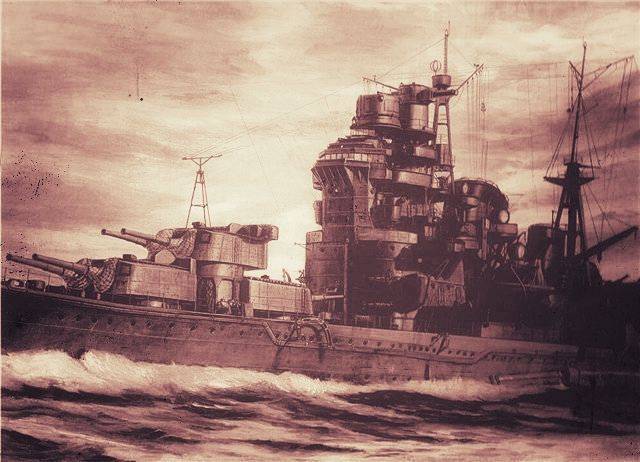
All this was achieved with a standard displacement, only 15-20% higher than the established limit. Of course, this fact did not explain the gap in the characteristics.
Almost all parties to the agreement violated the 10 tons limit, but for some reason, Mioko and Takao failed. Those who decided to follow the rules received a CRT with six GC guns (York) or unsatisfactory seaworthiness and a critical stability margin (American Wichita).
A case in point is Germany, whose heavy cruiser project was created in the absence of control and strict restrictions that are mandatory for the rest of the “contractual” cruisers. The standard displacement of the Hipper exceeded 14 tons (!), But this did not help the Germans. The result was a mediocre ship in all respects.
The Japanese surpassed everyone by building powerful cruisers without flaws in the framework of the established displacement.
It’s hard to deny the obvious. "Mioko", "Takao", "Mogami" carried five towers with 10 guns of the main caliber.
"Tone" - only four towers and 8 guns, but all - in the bow! Feed “Tone” was completely given for accommodation aviation.
Unlike American or Italian TKRs, completely devoid of torpedo weapons, Japanese cruisers were always armed with 610 mm long-lance caliber.
Four protected installations for launching torpedoes weighing tens of tons. And a whole compartment, similar to the factory floor, in which the assembly / disassembly / refueling and maintenance of oxygen torpedoes was carried out. By mass, all this is like the sixth tower of the Civil Code!
The Kotpon type boiler-turbine power plant developed twice as much power as the power plants of modern atomic icebreakers.
Japanese power plants had no analogues among the power plants of other "negotiated" cruisers, surpassing them in power by 1,3 ... 1,5 times.
Cruisers of the sons of Amaterasu carried armored shells weighing from 2000 to 2400 tons. This is less than the Italian "Zara" (2700 tons) or the German "Hipper" (2500 tons), but significantly more than all the other TCRs of this era.
The mass of the French Algeria's defense elements is 1723 tons. The values for Wichita and New Orleans are 1473 tons and 1508 tons, respectively (given excluding their deck armor).
Where did the Japanese find their displacement reserves?
Above we touched on all the important articles of the load, except for one element, the most massive: the case!
The Japanese cruisers body weighed significantly less than the rest of the representatives of this class. At Takao and Mogami, the hull weights were less than 30% of their standard displacement. Myoko has only 30,8%.
For comparison: the weight of the Zara’s hull was 42% of its standard displacement. Algeria has 38%. The British "York" - over 40%.
“Hipper”, despite its large size, had a traditional load distribution. Its hull (5750 tons) also accounted for more than 40% of its standard displacement.
Facilitation of Japanese TCR cases was achieved through the widespread use of 48-T titanium alloys with a yield strength of 720 MPa. Funny joke?
Dr. Yuzuru Hirag had neither titanium nor modern high-strength steels with a yield strength of 700-800 MPa. But his design team created the impossible.
The master forges his sword sometimes for months,
Speaking with him as if with his child.
And the fearless hero comes out of the horn,
Or maybe a killer with a slanting curve.
The Imperial Navy heavy cruisers had two hull features. One of them is visible even with the naked eye.
This lack of a forecastle and wave-like bends of the upper deck. The hull, being high in the area of the stem, smoothly "sagged" in the area of the towers - and again gained height in the middle part. Behind the aft towers, where nothing depended on the height of the side, the deck bent - and rushed down to the water.
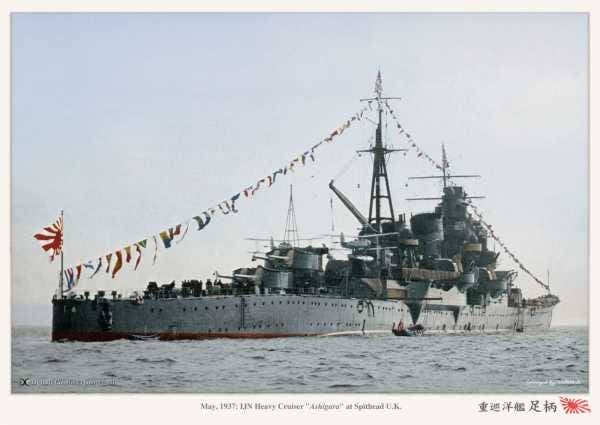
Walking on the upper deck of a Japanese ship was like climbing Mount Fuji.
The British haughtily declared that such design techniques are characteristic of amateurs. But what did their opinion matter? You have seen figures and facts!
The American Navy professed a different concept: all decks should be parallel to the constructive waterline. This approach simplified serial construction.
But the Japanese did not have the opportunity to build cruisers in large series. In ten years, they had only twelve "10000-ton" cruisers of four projects.
In each of them, the masters put their souls.
The second difference between the Japanese cruisers (true for the types "Mioko" and "Takao") was a partial lack of skin.
The role of the casing and shirstreka performed armored plates, included directly in the power set of the hull.
But the Japanese did not stop there.
Where powerful plates were fastened into a single monolith, the size of the spacing was 1200 mm (spacing is the distance between adjacent frames).
For the middle part of the hull over 80-90 meters, this meant about 1,5 times less power elements than cruisers in other countries. Mass saving again!
Of course, Yuzuru Hiraga was no more stupid than you and me. In the nasal part, which undergoes significant loads on the move, the size of the spacing decreased to 600 mm. The frequency of installation of frames (and with it the strength) in this place was higher than on European and American cruisers.
Thus, Hiraga created a surprisingly light and equal-strength “sword”!
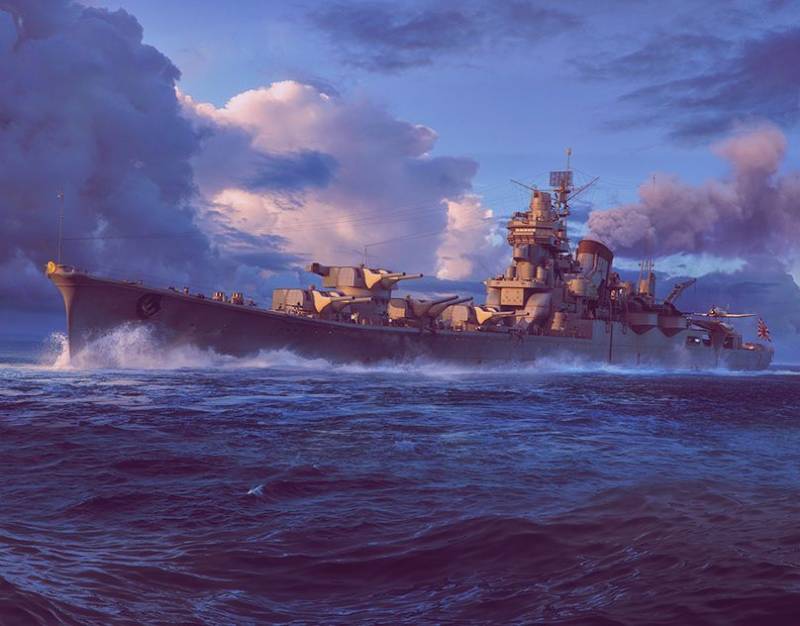
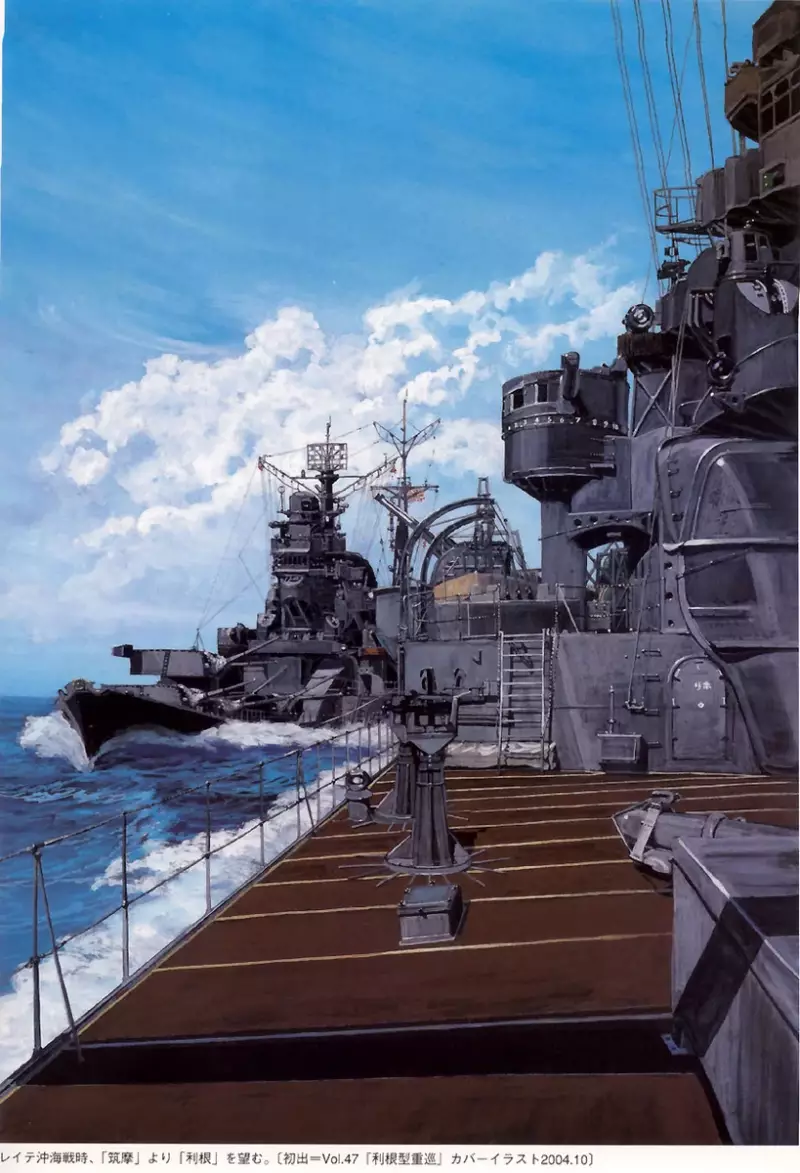
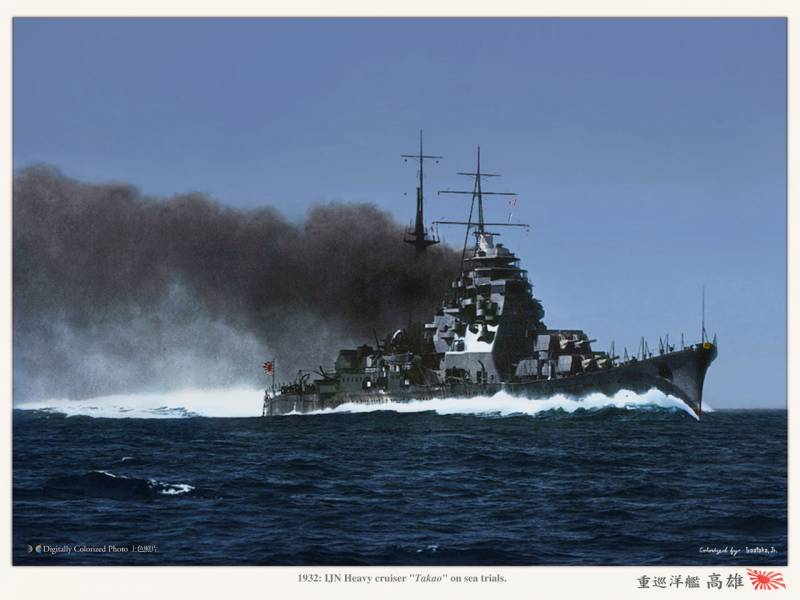
Information